
1
309
bid online at
(800) 978-COIN (2646)
|
$5 Gold
1820 S
QUARE
B
ASE
2 $5 C
APPED
H
EAD
1929
1820. Square Base 2 NGC graded AU Details. BD-2,
High Rarity 5.
Improperly Cleaned. Square Base 2, star 1
is distant from Liberty's bust, while star 13 is recut and
firmly touches the curl (the only Square 2 with this fea-
ture); large reverse letters with a tiny lump where the rear
talon usually hangs over the branch. A very scarce variety,
it is still the second most available Square Base 2 die pair-
ing and for the year, as the five varieties of curved base 2
are all rare to exceedingly rare. It is estimated that 20 to 25
BD-2s are known in various grades, mainly circulated to
low-end Mint State.
An important example of this highly sought after type. This
is a lightly circulated representative that has been lightly
cleaned at one time. Both sides exhibit some hairlines and
just a few small nicks and marks from handling -- nothing
serious. The dominant color is a yellow-gold with some
orange color here and there on the obverse with a dark
brown area on part of the reverse. Well struck throughout.
This lot will attract attention from type collectors that are
on a budget, as this coin will prove to be a rare opportunity.
(
PCGS # 8125
)
Estimated Value ........................................ $7,500 - 8,000
$5 Cl ass i c Head
M
INT
S
TATE
1835 $5 C
LASSIC
H
EAD
1930
1835
.
PCGS graded MS-62+
. Block 8 in Date. Both sides
are immersed in vivid bright golden color that accents the
rich satiny luster. Clear-cut devices are a result of having
been fully struck, with the dies themselves showing traces
of noticeable clashing on both the obverse and reverse.
There is a ghost image of the reverse shield lines around
Liberty's ear on the obverse. An impressive looking speci-
men that should delight any numismatist.
To permit America's gold coins to circulate at par, which
they had not done since 1815, Congress reduced the
authorized weight of the various denominations through
the Act of June 28, 1834. On August 2, 1834, the new stan-
dard went into effect; for the quarter eagle, the weight was
reduced from 8.75 grams to 8.36 grams. To readily distin-
guish the new coins from the old, modified designs were
introduced. Chief Engraver William Kneass created what we
now call the Classic Head. A head of Liberty faces left, her
hair secured by a band inscribed LIBERTY in raised letters,
13 stars circling her head, with the date below. The reverse
depicts an eagle with a shield on its breast, perched on an
olive branch and holding three arrows. UNITED STATES OF
AMERICA and 5 D. surround. The motto, E PLURIBUS
UNUM, used on half eagles since 1795, was omitted. Mint-
age quantities were large in the first several years of the
coinage span, with the high-water mark being 1834.
Pop
1; 37 finer
. (
PCGS # 8173
)
Estimated Value .........................................$7,000 - 7,500
1931
1837
.
PCGS graded EF-45.
CAC APPROVED.
Light golden
toning with typical wear for the assigned grade. Desirable as a
type coin selection. (
PCGS # 8175
)
Estimated Value .................................................$950 - 1,000
1932
1838
.
NGC graded EF-40.
CAC APPROVED.
Lightly toned in
the recesses of the design. Nominal wear with no mentionable
marks or distractions. (
PCGS # 8176
)
Estimated Value ................................................... $750 - 800
Ex: EPN Collection
.
$5 Liber ty/No Mot to
1933
1839
.
NGC graded EF-45
. Light yellow-gold surfaces with a
few minor handling marks and shallow digs on this first year of
issue. Still, considerably nicer than usually encountered as these
circulated widely and the surfaces are normally more abraded.
(
PCGS # 8191
)
Estimated Value ................................................... $600 - 650
1934
1840
.
NGC graded AU-53
. Light wear resides on each side as
do traces of original mint luster in the most protected areas of
the design elements. (
PCGS # 8194
)
Estimated Value ................................................... $900 - 950


